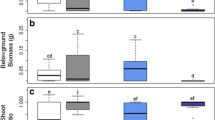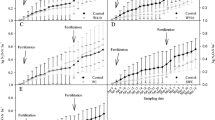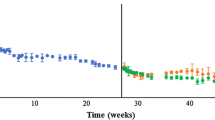Abstract
Soil degradation and desertification from agricultural land use is a serious and growing problem worldwide. Bringing degraded soils back into production is crucial to stop the cycle of land degradation, followed by abandonment and a subsequent shift of agricultural pressure to previously uncultivated soils. To return degraded and desertified landscapes to productivity, sandy soils must first be improved to enhance water and nutrient holding capacity. In this study we examine the ability of incorporated coarse woodchips to alter water holding capacity in very sandy, degraded soils in the field, complemented by soil column experiments in the laboratory examining the mechanisms behind changes in water retention. In the second phase of our lab studies, we examined nutrient losses, both soluble and gaseous, from laboratory-scale soil columns under different fertilization application regimes. Coarse woodchips incorporated into the soil increased water holding capacity by 16% in the field and 18% in the laboratory which was attributed to absorption of water by the woodchips, with limited evidence of the occurrence of flow path disruption. Soluble nutrient losses of nitrogen (N) and phosphorus (P) were smallest when fertilizer was applied in liquid form, as opposed to incorporated or surface-applied dry granules. Carbon dioxide emissions increased by 200% in the presence of woodchips, likely due to increased respiration by the microbial biomass. This study suggests that incorporating coarse wood chips into the soil is a viable strategy for increasing water and nutrient retention in very sandy and degraded soils and can provide a basis for enhancing ecological processes. More work is needed to examine whether increased water retention by woodchips also increases the availability of water and nutrients to plants.







Similar content being viewed by others
References
Ajwa, H. A., & Tabatabai, M. A. (1994). Decomposition of different organic materials in soils. Biology and Fertility of Soils, 18(3), 175–182. https://doi.org/10.1007/BF00647664.
Barnwell, T., Jackson, R., Elliott, E., Burke, I., Cole, C., Paustian, K., et al. (1992). An approach to assessment of management impacts on agricultural soil carbon. Water, Air, and Soil Pollution, 64(1–2), 423–435. https://doi.org/10.1007/BF00477114.
Bouwman, A. F., Van Vuuren, D. P., Derwent, R. G., & Posch, M. (2002). A global analysis of acidification and eutrophication of terrestrial ecosystems. Water, Air, and Soil Pollution, 141(1–4), 349–382. https://doi.org/10.1023/A:1021398008726.
Bridges, E. M., & Oldeman, L. R. (1999). Global assessment of human-induced soil degradation. Arid Soil Research and Rehabilitation, 13(4), 319–325. https://doi.org/10.1080/089030699263212.
Buchanan, J. R., Yoder, D. C., Denton, H. P., & Smoot, J. L. (2002). Wood chips as a soil cover for construction sites with steep slopes. Applied Engineering in Agriculture, 18(6). https://doi.org/10.13031/2013.11322.
Bugbee, G. J. (1999). Effects of hardwood sawdust in potting media containing biosolids compost on plant growth, fertilizer needs, and nitrogen leaching. Communications in Soil Science and Plant Analysis, 30(5–6), 689–698. https://doi.org/10.1080/00103629909370238.
Carpenter, S. R., Caraco, N. F., Correll, D. L., Howarth, R. W., Sharpley, A. N., & Smith, V. H. (1998). Nonpoint pollution of surface waters with phosphorus and nitrogen. Ecological Applications, 8(3), 559 https://doi.org/10.2307/2641247.
D’Odorico, P., Bhattachan, A., Davis, K. F., Ravi, S., & Runyan, C. W. (2013). Global desertification: drivers and feedbacks. Advances in Water Resources, 51, 326–344. https://doi.org/10.1016/j.advwatres.2012.01.013.
Dempster, D. N., Jones, D. L., & Murphy, D. V. (2012). Clay and biochar amendments decreased inorganic but not dissolved organic nitrogen leaching in soil. Soil Research, 50(3), 216–221. https://doi.org/10.1071/SR11316.
Fang, S., Xie, B., Liu, D., & Liu, J. (2011). Effects of mulching materials on nitrogen mineralization, nitrogen availability and poplar growth on degraded agricultural soil. New Forests, 41(2), 147–162. https://doi.org/10.1007/s11056-010-9217-9.
Ferrini, F., Fini, A., Frangi, P., & Amoroso, G. (2008). Mulching of ornamental trees: effects on growth and physiology. Arboriculture & Urban Forestry, 34(3), 157.
Foley, J. A., DeFries, R., Asner, G. P., Barford, C., et al. (2005). Global consequences of land use. Science; Washington, 309(5734), 570–574.
Fueki, N., Lipiec, J., Kuś, J., Kotowska, U., & Nosalewicz, A. (2012). Difference in infiltration and macropore between organic and conventional soil management. Soil Science and Plant Nutrition, 58(1), 65–69. https://doi.org/10.1080/00380768.2011.644759.
Gardner, W. C., Broersma, K., Naeth, A., Chanasyk, D., & Jobson, A. (2010). Influence of biosolids and fertilizer amendments on physical, chemical and microbiological properties of copper mine tailings. Canadian Journal of Soil Science, 90(4), 571–583. https://doi.org/10.4141/cjss09067.
Ghane, E., Fausey, N. R., & Brown, L. C. (2014). Non-Darcy flow of water through woodchip media. Journal of Hydrology, 519, 3400–3409. https://doi.org/10.1016/j.jhydrol.2014.09.065.
Ghane, E., Feyereisen, G. W., & Rosen, C. J. (2016). Non-linear hydraulic properties of woodchips necessary to design denitrification beds. Journal of Hydrology, 542, 463–473. https://doi.org/10.1016/j.jhydrol.2016.09.021.
Głąb, T., & Kulig, B. (2008). Effect of mulch and tillage system on soil porosity under wheat (Triticum aestivum). Soil and Tillage Research, 99(2), 169–178. https://doi.org/10.1016/j.still.2008.02.004.
Groffman, P. M., Butterbach-Bahl, K., Fulweiler, R. W., Gold, A. J., Morse, J. L., Stander, E. K., et al. (2009). Challenges to incorporating spatially and temporally explicit phenomena (hotspots and hot moments) in denitrification models. Biogeochemistry, 93(1), 49–77. https://doi.org/10.1007/s10533-008-9277-5.
Heinonen, J. K., & Lahti, R. J. (1981). A new and convenient colorimetric determination of inorganic orthophosphate and its application to the assay of inorganic pyrophosphatase. Analytical Biochemistry, 113(2), 313–317. https://doi.org/10.1016/0003-2697(81)90082-8.
Hudson, B. D. (1994). Soil organic matter and available water capacity. Journal of Soil and Water Conservation, 49(2), 189–194.
Kasongo, R. K., Verdoodt, A., Kanyankagote, P., Baert, G., & Ranst, E. V. (2011). Coffee waste as an alternative fertilizer with soil improving properties for sandy soils in humid tropical environments. Soil Use and Management, 27(1), 94–102. https://doi.org/10.1111/j.1475-2743.2010.00315.x.
Khaleel, R., Reddy, K. R., & Overcash, M. R. (1981). Changes in soil physical properties due to organic waste applications: a review 1. Journal of Environmental Quality, 10(2), 133. https://doi.org/10.2134/jeq1981.00472425001000020002x.
Khan, A. U.-H., & Jury, W. A. (1990). A laboratory study of the dispersion scale effect in column outflow experiments. Journal of Contaminant Hydrology, 5(2), 119–131. https://doi.org/10.1016/0169-7722(90)90001-W.
Kidd, J., Manning, P., Simkin, J., Peacock, S., & Stockdale, E. (2017). Impacts of 120 years of fertilizer addition on a temperate grassland ecosystem. PLoS One, 12(3), e0174632. https://doi.org/10.1371/journal.pone.0174632.
Kinney, T. J., Masiello, C. A., Dugan, B., Hockaday, W. C., Dean, M. R., Zygourakis, K., & Barnes, R. T. (2012). Hydrologic properties of biochars produced at different temperatures. Biomass and Bioenergy, 41, 34–43. https://doi.org/10.1016/j.biombioe.2012.01.033.
Knighton, J. O., & Walter, M. T. (2016). Critical rainfall statistics for predicting watershed flood responses: rethinking the design storm concept. Hydrological Processes, 30(21), 3788–3803. https://doi.org/10.1002/hyp.10888.
Laird, D., Fleming, P., Wang, B., Horton, R., & Karlen, D. (2010). Biochar impact on nutrient leaching from a Midwestern agricultural soil. Geoderma, 158(3), 436–442. https://doi.org/10.1016/j.geoderma.2010.05.012.
Lal, R. (2003). Soil erosion and the global carbon budget. Environment International, 29(4), 437–450. https://doi.org/10.1016/S0160-4120(02)00192-7.
Larney, F. J., & Angers, D. A. (2012). The role of organic amendments in soil reclamation: a review. Canadian Journal of Soil Science, 92(1), 19–38. https://doi.org/10.4141/cjss2010-064.
Li, Z., Schneider, R. L., Morreale, S. J., Xie, Y., Li, C., & Li, J. (2018). Woody organic amendments for retaining soil water, improving soil properties and enhancing plant growth in desertified soils of Ningxia, China. Geoderma, 310, 143–152. https://doi.org/10.1016/j.geoderma.2017.09.009.
Li, Z., Qiu, K., Schneider, R. L., Morreale, S. J., & Xie, Y. (2019a). Comparison of microbial community structures in soils with woody organic amendments and soils with traditional local organic amendments in Ningxia of Northern China. PeerJ, 7, e6854. https://doi.org/10.7717/peerj.6854.
Li, Z., Schneider, R. L., Morreale, S. J., Xie, Y., Li, J., Li, C., & Ni, X. (2019b). Using woody organic matter amendments to increase water availability and jump-start soil restoration of desertified grassland soils of Ningxia, China. Land Degradation & Development. https://doi.org/10.1002/ldr.3315.
Lyon, T. L., & Buckman, H. O. (1943). The nature and properties of soils. Soil Science, 56(3), 242.
McPhillips, L. E., Groffman, P. M., Schneider, R. L., & Walter, M. T. (2016). Nutrient cycling in grassed roadside ditches and lawns in a suburban watershed. Journal of Environmental Quality, 45(6), 1901–1909. https://doi.org/10.2134/jeq2016.05.0178.
McSwiney, C. P., & Robertson, G. P. (2005). Nonlinear response of N2O flux to incremental fertilizer addition in a continuous maize (Zea mays L.) cropping system. Global Change Biology, 11(10), 1712–1719. https://doi.org/10.1111/j.1365-2486.2005.01040.x.
Meffe, R., de Miguel, Á., Martínez Hernández, V., Lillo, J., & de Bustamante, I. (2016). Soil amendment using poplar woodchips to enhance the treatment of wastewater-originated nutrients. Journal of Environmental Management, 180, 517–525. https://doi.org/10.1016/j.jenvman.2016.05.083.
Molodovskaya, M., Singurindy, O., Richards, B. K., Warland, J., Johnson, M. S., & Steenhuis, T. S. (2012). Temporal variability of nitrous oxide from fertilized croplands: hot moment analysis. Soil Science Society of America Journal, 76(5), 1728–1740. https://doi.org/10.2136/sssaj2012.0039.
NOAA (2015). National Centers for Environmental Information. Global Historical Climatology Network. Meteorological Station Number USC00325479. Available from: https://gis.ncdc.noaa.gov/maps/ncei/cdo/daily.
NOAA (2017). Atlas 4 Point Precipitation Frequency Estimates: ND. Meteorological Station Number USC00325479. Available from: https://hdsc.nws.noaa.gov/hdsc/pfds/pfds_map_cont.html?bkmrk=nd.
O'Dell J. W. (1993). US EPA Method 353.2, Revision 2.0. http://www.epa.gov/Region6/6lab/methods/353_2.pdf.
Oertel, C., Matschullat, J., Zurba, K., Zimmermann, F., & Erasmi, S. (2016). Greenhouse gas emissions from soils—a review. Chemie der Erde - Geochemistry, 76(3), 327–352. https://doi.org/10.1016/j.chemer.2016.04.002.
Oyarzun, C., Aracena, C., Rutherford, P., Godoy, R., & Deschrijver, A. (2007). Effects of land use conversion from native forests to exotic plantations on nitrogen and phosphorus retention in catchments of Southern Chile. Water, Air, and Soil Pollution, 179(1–4), 341–350. https://doi.org/10.1007/s11270-006-9237-4.
Parfitt, R. L., Giltrap, D. J., & Whitton, J. S. (1995). Contribution of organic matter and clay minerals to the cation exchange capacity of soils. Communications in Soil Science and Plant Analysis, 26(9–10), 1343–1355. https://doi.org/10.1080/00103629509369376.
Parkin, T., & Venterea, R. (2010). Chapter 3. GRACEnet trace gas sampling protocols.pdf. In Sampling Protocols (pp. 3–1 to 3–39). https://www.ars.usda.gov/ARSUserFiles/np212/Chapter%203.%20GRACEnet%20Trace%20Gas%20Sampling%20Protocols.pdf. Accessed 8 May 2018.
Pelisser, F., Zavarise, N., Longo, T. A., & Bernardin, A. M. (2011). Concrete made with recycled tire rubber: effect of alkaline activation and silica fume addition. Journal of Cleaner Production, 19(6), 757–763 https://doi.org/10.1016/j.jclepro.2010.11.014.
Peters, A., & Durner, W. (2006). Improved estimation of soil water retention characteristics from hydrostatic column experiments. Water Resources Research, 42(11). https://doi.org/10.1029/2006WR004952.
Pluer, W. T., Geohring, L. D., Steenhuis, T. S., & Walter, M. T. (2016). Controls influencing the treatment of excess agricultural nitrate with denitrifying bioreactors. Journal of Environmental Quality, 45(3), 772–778. https://doi.org/10.2134/jeq2015.06.0271.
Prats, S. A., MacDonald, L. H., Monteiro, M., Ferreira, A. J. D., Coelho, C. O. A., & Keizer, J. J. (2012). Effectiveness of forest residue mulching in reducing post-fire runoff and erosion in a pine and a eucalypt plantation in north-central Portugal. Geoderma, 191, 115–124. https://doi.org/10.1016/j.geoderma.2012.02.009.
Reicosky, D. C., Dugas, W. A., & Torbert, H. A. (1997). Tillage-induced soil carbon dioxide loss from different cropping systems. Soil and Tillage Research, 41(1), 105–118. https://doi.org/10.1016/S0167-1987(96)01080-X.
Roberts, T. L. (2007). Right product, right rate, right time and right place... the foundation of best management practices for fertilizer. In Fertilizer Best Management Practices (pp. 29–32). International Fertilizer Industry Association. http://www.flipbooksoft.com/upload/books/10-2011/d04ebdcf58f732b3a57e168a032fa516/2007_ifa_fbmp_workshop_brussels.pdf#page=36. Accessed 8 May 2018.
Smith, P., Martino, D., Cai, Z., Gwary, D., Janzen, H., Kumar, P., et al. (2008). Greenhouse gas mitigation in agriculture. Philosophical Transactions of the Royal Society, B: Biological Sciences, 363(1492), 789–813. https://doi.org/10.1098/rstb.2007.2184.
Sponseller, R. A. (2007). Precipitation pulses and soil CO2 flux in a Sonoran Desert ecosystem. Global Change Biology, 13(2), 426–436. https://doi.org/10.1111/j.1365-2486.2006.01307.x.
Truhlar, A. M., Rahm, B. G., Brooks, R. A., Nadeau, S. A., Makarsky, E. T., & Walter, M. T. (2016). Greenhouse gas emissions from septic systems in New York State. Journal of Environmental Quality, 45(4), 1153–1160. https://doi.org/10.2134/jeq2015.09.0478.
Van Es, H. M., Schindelbeck, R. R., & Jokela, W. E. (2004). Effect of manure application timing, crop, and soil type on phosphorus leaching. Journal of Environmental Quality, 33(3), 1070–1080.
van Es, H. M., Sogbedji, J. M., & Schindelbeck, R. R. (2006). Effect of manure application timing, crop, and soil type on nitrate leaching. Journal of Environmental Quality, 35(2), 670. https://doi.org/10.2134/jeq2005.0143.
Zwingmann, N., Singh, B., Mackinnon, I. D. R., & Gilkes, R. J. (2009). Zeolite from alkali modified kaolin increases NH4+ retention by sandy soil: column experiments. Applied Clay Science, 46(1), 7–12. https://doi.org/10.1016/j.clay.2009.06.012.
Acknowledgments
Thank you to Andrew Carrlson and Justin Feld with USDA-ARS for establishing and maintaining the research site at Mandan, ND. Thank you to Erika Mudrak of the Cornell Statistical Consulting Unit for her help improving the statistical analyses presented here.
Funding
This material is based upon work supported by the National Science Foundation Graduate Research Fellowship under Grant No. DGE-1144153. This work was also funded in part by the National Science Foundation IGERT program and the Ningxia Forestry Institute of Yinchuan, Ningxia, China.
Author information
Authors and Affiliations
Corresponding author
Additional information
Publisher’s Note
Springer Nature remains neutral with regard to jurisdictional claims in published maps and institutional affiliations.
Electronic Supplementary Material
ESM 1
(DOCX 302 kb)
Rights and permissions
About this article
Cite this article
Menzies Pluer, E.G., Schneider, R., Morreale, S. et al. Returning Degraded Soils to Productivity: an Examination of the Potential of Coarse Woody Amendments for Improved Water Retention and Nutrient Holding Capacity. Water Air Soil Pollut 231, 15 (2020). https://doi.org/10.1007/s11270-019-4380-x
Received:
Accepted:
Published:
DOI: https://doi.org/10.1007/s11270-019-4380-x




